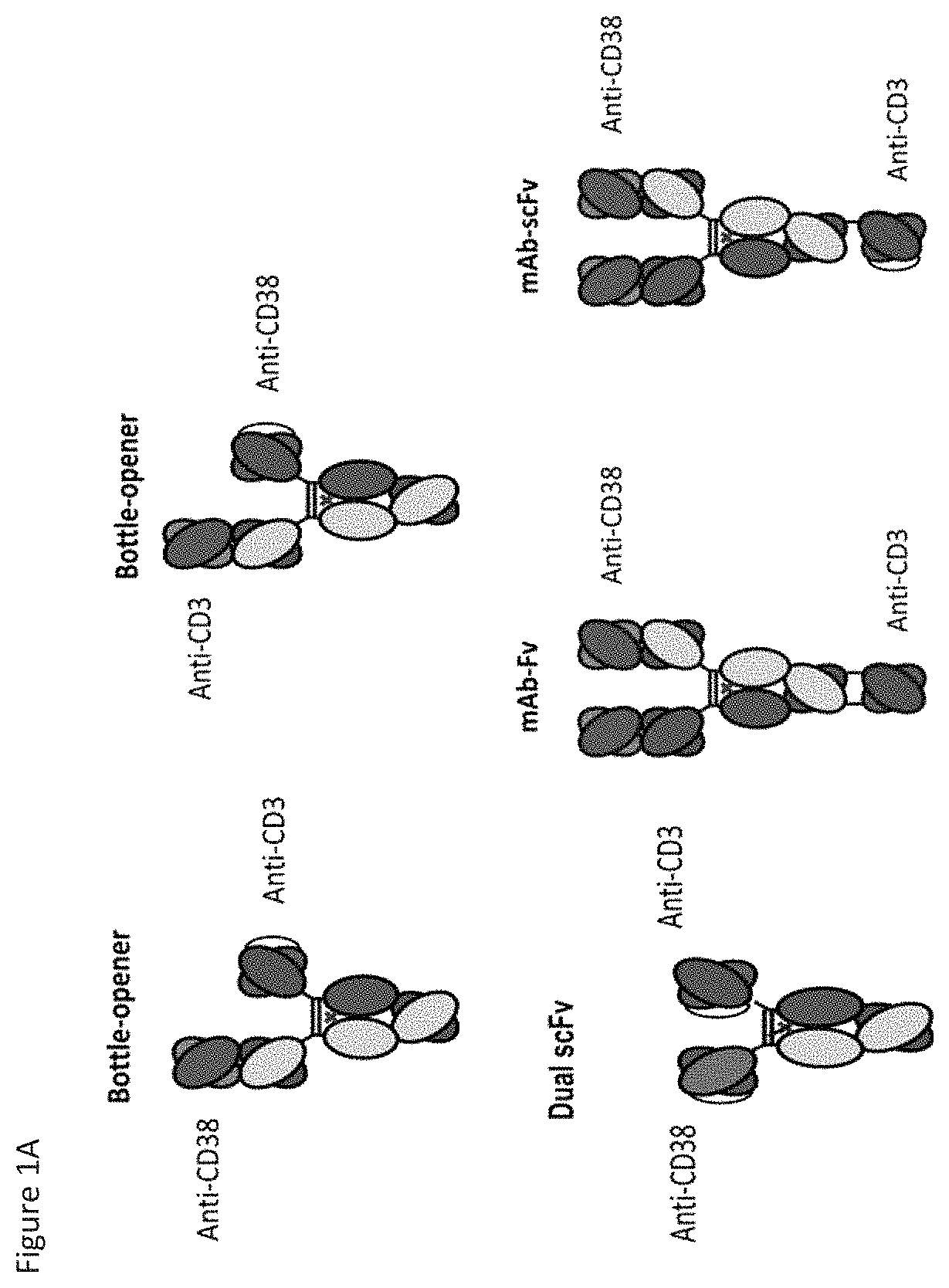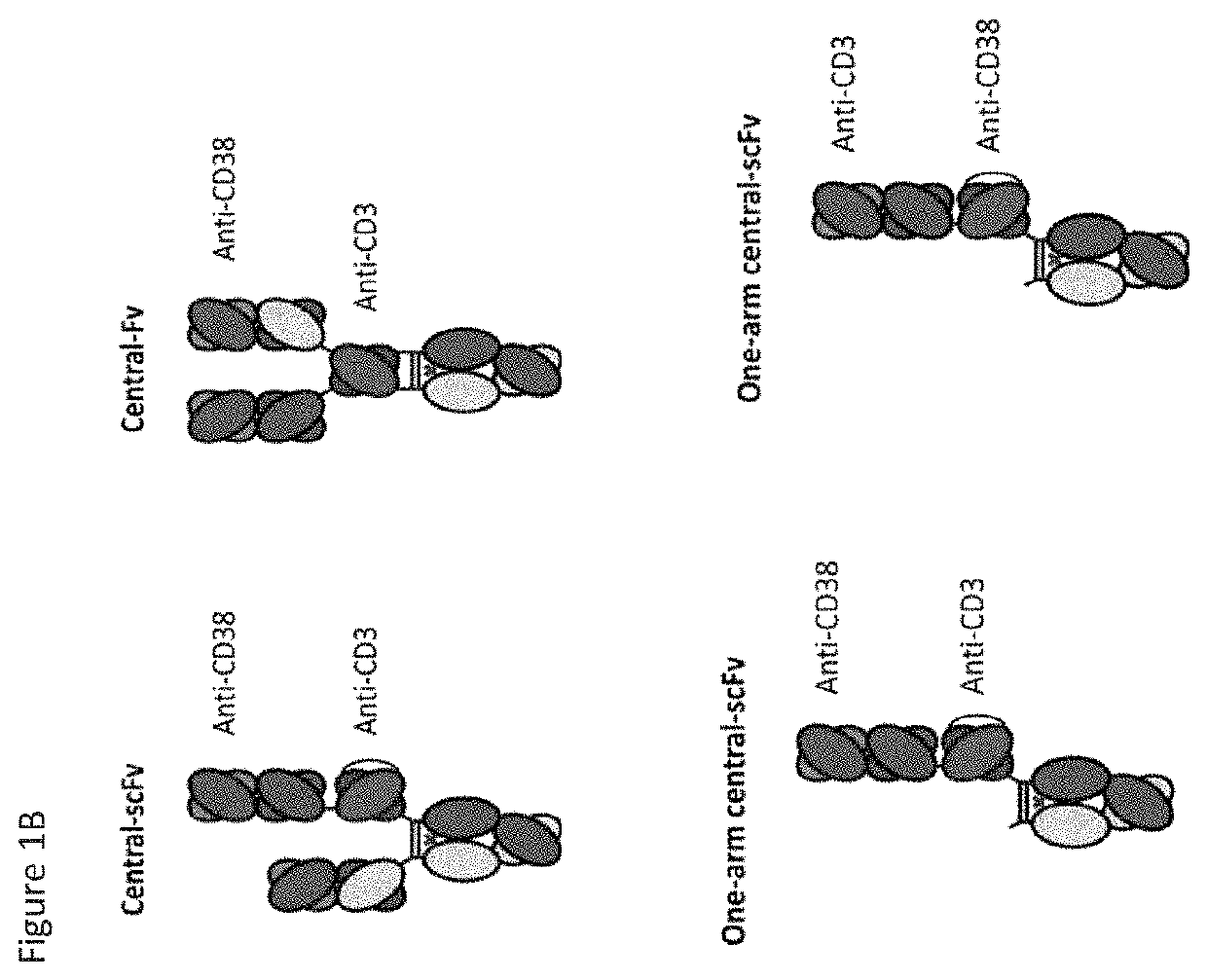Heterodimeric antibodies that bind CD3 and CD38
a technology of heterodimeric antibodies and cd38, which is applied in the direction of antibody medical ingredients, drug compositions, peptides, etc., can solve the problems of cd38 binding to the new antigen always bivalent, antibody fragments typically lack the constant region of the antibody with its associated functional properties, and the production and stability of the antibody
- Summary
- Abstract
- Description
- Claims
- Application Information
AI Technical Summary
Benefits of technology
Problems solved by technology
Method used
Image
Examples
example 1
Alternate Formats
[0297]Fab-scFv-Fc Production
[0298]DNA encoding the three chains needed for Fab-scFv-Fc expression—Fab-Fc, scFv-Fc, and LC—were generated by gene synthesis (Blue Heron Biotechnology, Bothell, Wash.) and were subcloned using standard molecular biology techniques into the expression vector pTT5. Substitutions were introduced using either site-directed mutagenesis (QuikChange, Stratagene, Cedar Creek, Tex.) or additional gene synthesis and subcloning. DNA was transfected into HEK293E cells for expression and resulting proteins were purified from the supernatant using protein A affinity (GE Healthcare) and cation exchange (GE Healthcare) chromatography. Amino acid sequences for Fab-scFv-Fc bispecifics are listed in FIG. 3.
[0299]Surface Plasmon Resonance Affinity Determination
[0300]Surface plasmon resonance binding experiments were performed using a Biacore 3000 instrument (data not shown). Even after amino acids substitution(s) to modulate affinity, the anti-CD3 variable...
example 2
Alternate Formats
[0307]Bispecifics Production
[0308]Cartoon schematics of anti-CD38×anti-CD3 bispecifics are shown in FIG. 1. Amino acid sequences for alternate format anti-CD38×anti-CD3 bispecifics are listed in FIG. 39 to FIG. 43. DNA encoding the three chains needed for bispecific expression were generated by gene synthesis (Blue Heron Biotechnology, Bothell, Wash.) and were subcloned using standard molecular biology techniques into the expression vector pTT5. Substitutions were introduced using either site-directed mutagenesis (QuikChange, Stratagene, Cedar Creek, Tex.) or additional gene synthesis and subcloning. DNA was transfected into HEK293E cells for expression and resulting proteins were purified from the supernatant using protein A affinity (GE Healthcare) and cation exchange chromatography. Yields following protein A affinity purification are shown in FIG. 35. Cation exchange chromatography purification was performed using a HiTrap SP HP column (GE Healthcare) with a was...
example 3
[0311]Redirected T Cell Cytotoxicity
[0312]Anti-CD38×anti-CD3 Fab-scFv-Fc bispecifics were characterized in vitro for redirected T cell cytotoxicity (RTCC) of the CD38+ RPMI8266 myeloma cell line. 40 k RPMI8266 cells were incubated for 96 h with 400 k human PBMCs. RTCC was measured by flow cytometry as indicated (see FIG. 44). CD4+ and CD8+ T cell expression of CD69, Ki-67, and PI-9 were also characterized by flow cytometry and are shown in FIG. 45.
[0313]Mouse Model of Anti-Tumor Activity
[0314]Four groups of five NOD scid gamma (NSG) mice each were engrafted with 5×106 RPMI8226TrS tumor cells (multiple myeloma, luciferase-expressing) by intravenous tail vein injection on Day −23. On Day 0, mice were engrafted intraperitoneally with 10×106 human PBMCs. After PBMC engraftment on Day 0, test articles are dosed weekly (Days 0, 7) by intraperitoneal injection at dose levels indicated in FIG. 4. Study design is further summarized in FIG. 46. Tumor growth was monitored by measuring total fl...
PUM
| Property | Measurement | Unit |
|---|---|---|
| molecular weight | aaaaa | aaaaa |
| molecular weight | aaaaa | aaaaa |
| pH | aaaaa | aaaaa |
Abstract
Description
Claims
Application Information
 Login to View More
Login to View More - R&D
- Intellectual Property
- Life Sciences
- Materials
- Tech Scout
- Unparalleled Data Quality
- Higher Quality Content
- 60% Fewer Hallucinations
Browse by: Latest US Patents, China's latest patents, Technical Efficacy Thesaurus, Application Domain, Technology Topic, Popular Technical Reports.
© 2025 PatSnap. All rights reserved.Legal|Privacy policy|Modern Slavery Act Transparency Statement|Sitemap|About US| Contact US: help@patsnap.com



